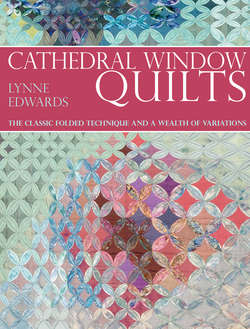Читать книгу Cathedral Window Quilts - Lynne Edwards - Страница 29
На сайте Литреса книга снята с продажи.
Cutting the Squares
ОглавлениеEach folded square of background fabric starts out as a larger cut square. There is an easy way to calculate this: choose the finished size of the folded square, e.g., 3in × 3in (7.6cm × 7.6cm). Double this measurement and then add 1⁄2in (1.3cm) for the seam allowances – this will be the size of the cut square of fabric needed at the start. For example, a 3in x 3in (7.6cm × 7.6cm) folded square will need 3in + 3in + 1⁄2in (7.6cm + 7.6cm + 1.3cm) = a 61⁄2in (16.5cm) cut square of fabric.
I use this size for most of my projects, especially for those mixing squares and rectangles as the calculations are simpler. Alternatively I like to use a larger square (cut 8in × 8in / 20.3cm × 20.3cm) which is a nonsense mathematically as it finishes up as a 33⁄4in × 33⁄4in (9.5cm × 9.5cm) folded square, but is visually very satisfying and a comfortable size to work with. Refer to the table below for other cutting and finishing sizes.
| Cut size of fabric square | Finished size of block |
|---|---|
| 41⁄2in × 41⁄2in | 2in × 2in |
| (11.4cm × 11.4cm) | (5.1cm × 5.1cm) |
| 61⁄2in × 61⁄2in | 3in × 3in |
| (16.5cm × 16.5cm) | (7.6cm × 7.6cm) |
| 81⁄2in × 81⁄2in | 4in × 4in |
| (21.6cm × 21.6cm) | (10.2cm × 10.2cm) |
| 101⁄2in × 101⁄2in | 5in x 5in |
| (26.7cm × 26.7cm) | (12.7cm × 12.7cm) |
| 121⁄2in × 121⁄2in | 6in x 6in |
| (31.8cm × 31.8cm) | (15.2cm × 15.2cm) |
4 Pull the open edges of the folded square apart and refold with the seamlines matching. Pin, then stitch from each corner to within 1in (2.5cm) of the centre seam, leaving longer threads at the folded ends as before (Fig 4).
Fig 4
5 Trim the two remaining corners and pull the threads as before while finger-pressing the seams open, including the unstitched section across the centre of the square (Fig 5).
Fig 5
6 Turn each folded square right side out through the centre opening. Use a large pin (i.e., one that isn’t too sharp and doesn’t do too much damage) to ease out each corner. Hold the opened seam allowances firmly between thumb and forefinger as you turn so that they stay open. The aim is to finish up with the corners of the square as flat and pointed as possible (Fig 6).
Fig 6
7 Using a steam iron, take one square of fabric and press lightly around the outer folded edges, pulling the corners out as much as possible as you do so. Don’t expect the shape to lie flat at this stage – fabric seldom behaves as you wish it to! If you wish to join blocks by machine, turn to steps 1–12 Joining Square Blocks by Machine page 20.
8 Bring two adjacent corners (A and B in Fig 7) to meet at the centre of the folded square. Ideally they will meet at the centre and make a sharp outer corner. If not, and the outer corner is blunt, don’t worry – this often happens. To correct it, pull corners A and B together over the centre area a little, keeping them level with each other. Pinch the outer corner to make it sharp and press firmly with the steam iron, ironing from the outer corner in towards the centre. The two folded edges of fabric being pressed are on the bias and can be shrunk slightly with a steam iron. Restrict the pressing area to a narrow strip between the outer corner and the centre. Leave the rest of the outer folded sides unpressed at this stage (Fig 8). The important thing is to have a really sharp outer corner. Never press from the centre of the square outwards or you will lose those sharp corners. If corners A and B do not reach the centre of the square but seem too short, just pull them – they are bias and will stretch easily.
Fig 7
Fig 8
9 Bring corner C in to the centre. Adjust corner B if necessary so B and C are level with each other. Pinch the outer corner to sharpen it and press in the same way as the first corner. Treat problems in the same way as before (Fig 9). Press, ironing only a narrow strip from the new sharp corner into the centre. If corners A, B and C are not all meeting dead centre, don’t worry too much – it’s sharp outer corners that matter.
Fig 9
10 Repeat the process with corner D, making a sharp corner between C and D first, then tackling the corner between D and A (Fig 10).
Fig 10
11 Once all the corners are fixed, press the whole block with the steam iron, pressing along the outside edges and then from the outer corners towards the centre.
